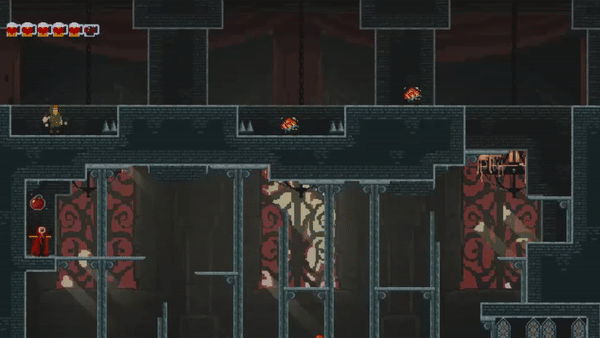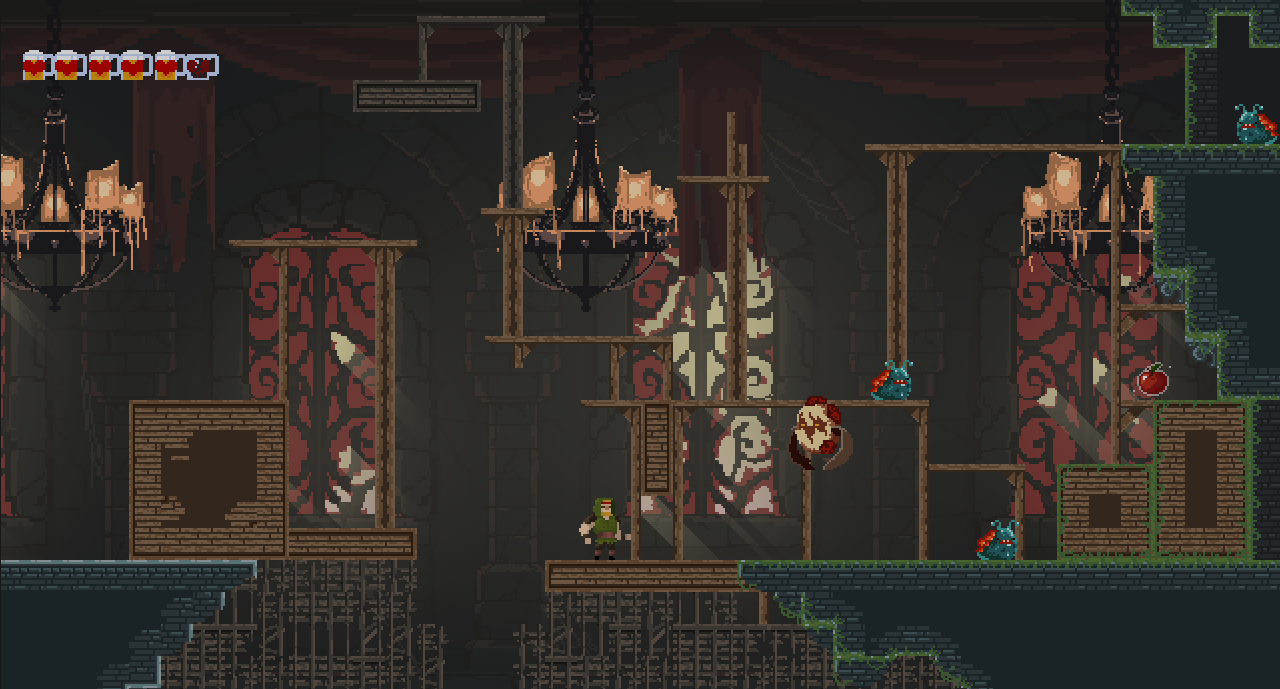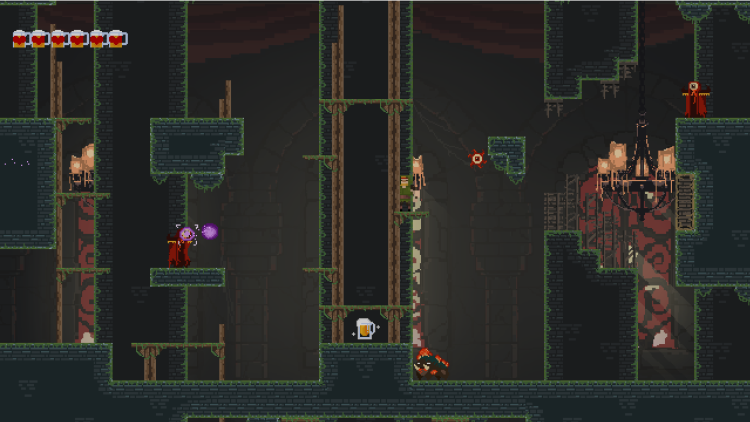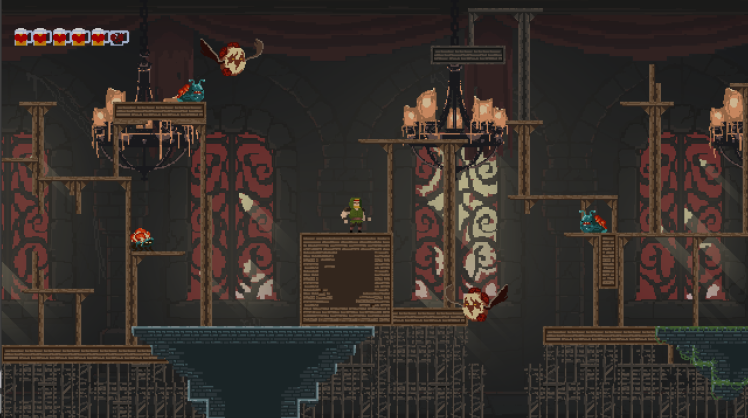Development
CHADDIUS MAXIMUS is a “Metroidvania-like” single player game with a pixel art style, combining features from the classic games ‘Castlevania’ and ‘Metroid’. The game has been made by a group of students at BUas within the course of 8 weeks. The game is created using a fully custom engine.
Game Bio: Chaddius Maximus is a Metroidvania built in a Pixel Platformer Engine.
Genre: Metroidvania/2D Platformer
Highlighted Features: 1-Size-Fits-All weapon, Custom Engine
Technology Used: Visual Studio, Jenkins, Perforce, Tiled, Aseprite, FMOD studio 2.0
Platforms: Switch & Windows, released on PC.
Release Date: June 14, 2019
My Role: Level Designer & Producer.

Playtime
30 minutes

Development Time
8 weeks

Team Size
18 Students

Best Tech IGAD Year 2 – 2018/2019
Level Design
I was responsible for 4 levels that made it into the final game.
Below is the development process of each level.
Castle Tower
Concept
In game, this is the fifth room you enter, and your first entry into the Castle.
It is divided in 3 parts, forcing the player down in a Z motion to reach Level 6.
The main challenge was a gradually more tense jumping section via enemies.
The original sketch (right) that inspired the gameplay for this level relied more on an increase in enemies than platforming. This carried over by having each floor host a different enemy.
Reflection
Especially for this level I wish I had more sketches available, but due to the limited amount of time available I based it all on one sketch. The level came out well, with an extra part added at the bottom, and 2 secret health options in the top right in the first part and on the right in the second part.
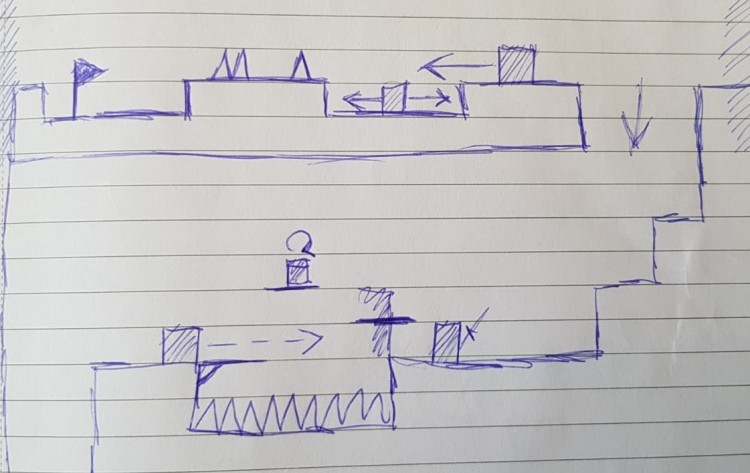

Iteration
The level went through multiple iterations, but 3 of them highlighted the most important changes, as described below:
The First Iteration I added extra space to the top of the level to avoid the player leaving the screen when jumping. As well as some background tiles for better decoration for the structure.
The Second Iteration was primarily gameplay updates in the middle part; I broke up the platforms, updated the fake wall with a health item, and decorated more of the background.
The last major Iteration I replaced the lava with spikes due to an at the time issue with collision. I also integrated player feedback on the fake wall and send more tile to the background so the player character wasn’t obscured anymore. Finally some extra “ruined” décor for the background to create consistency in the thick pillars from the top.
Reflection
I think I am most proud of this level in the end. It’s simple but effective, and has a clear flow to it.
I don’t think a lot of people ended up finding the secret room in the top right, which I could have possibly hinted at more or given more purpose.
I would have rather kept the Lava or added more color to this level, but it was not of a high enough priority to preoccupy myself with.
The Bridge
Concepting
A lot of changes went into The Bridge before the final product. It went through the entire development process twice.
Despite being based on multiple sketches, the first few iterations were lacking in level of quality and fun.
The original idea started off as a simple bridge connecting two towers with a path on top of the bridge, and an army of enemies patrolling the bridge. Not only did an army of enemies cause issues with the custom engine, it also made for boring gameplay to just jump over them. So I added more flying enemies to the level.
This didn’t fix the issue, so I went back to the drawing board to make it more of a dilapidated bridge (right), on the verge of collapse, bringing back more platforming challenges into the level.
The end result of this second draft came out a lot better. Internally dubbed “Blighttown” it turns out to be the hardest level in the game due to the amount of flying enemies, but there was no more time to balance it properly.
Reflection
This level best highlights the struggle of time pressure our team experienced, and I personally experienced balancing Production and Level Design at the same time. However glad I am going back to the drawing board to make this penned sketch, I do agree that the difficulty rating spikes in this level. Nevertheless, I am by far the proudest of this level. I like the look and challenge in it. It reveals to me that we could have done more.

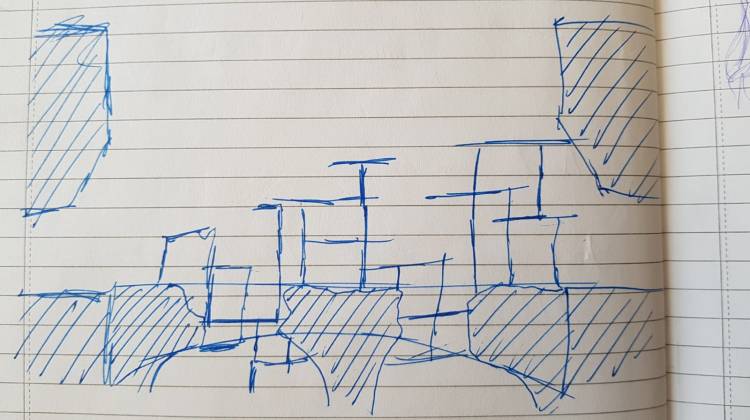
Final Bridge Look

The Broken Bridge
As part of the Metroidvania aspect of the game, there was always a plan for the bridge to collapse and open up a new path to the third part of the game. This would be a downhill path where the player earns their weapon upgrade. I made broken varieties of each bridge iteration, which generally stayed consistent in their design.
There were some issues with The Broken Bridge, since we had no visual or audio cue this would happen, and no feedback that dropping down was safe for the player.
The way I tried to solve that was by putting a false jump in there which would cause the player to drop down into the next level. I wasn’t satisfied with it, but it functioned well enough.
Reflection
I’m probably least satisfied with this level. I carries very little meaning and is poorly communicated to the player. It is also very short, since 2/3rds is cut off from the player.
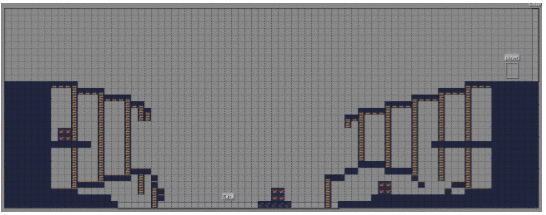

Moss Tower
Concept
Moss Tower is the crossroads of Chaddius Maximus. During your playthrough, you revisit the Moss Tower 3 times, and every time you do, you approach it from a different angle and with details in the level have changed. This would allow you to find the next path to progress the game, giving the game some of that Metroidvania feel.
On the very first time you enter, you just surpassed The Bridge, and stand on the top left corner of the map. Jumping down, you can already see hints of the the bottom part, but cannot reach it from the middle point. The top right is too far away to jump, but there is the hint of rotten wood on the wall to indicate you will need to do something special to get there. The only other exit available at this point is in the middle, on your right. When you exit through this point, you are awarded with a health item, but at a dead end.
When you inevitably turn back around, the room looks similar but has changed slightly. Some of the scaffolding is gone, and a large wooden box that blocked the wall in the middle on the left side of the room is now gone. This is allows you to go through a new exit, whilst the bottom half of the map is still locked off.
The third time you enter the Moss Tower isn’t until much later, and it is from the bottom left. At this point, you have acquired an ability for the spear to act as an extra platform when you throw it into a wall. We have already conveyed that the rotten wood means it’s where you want to throw your spear. You have to work your way through the bottom half to find that there is now a passage open to reach the middle & top half of the map from the bottom half. Since the player can now reach the top left exit with the spear upgrade, a new exit has become available, and the player can make their way into the Boss Room
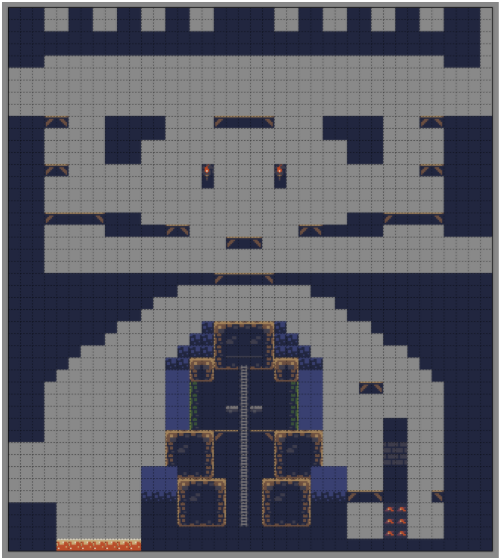
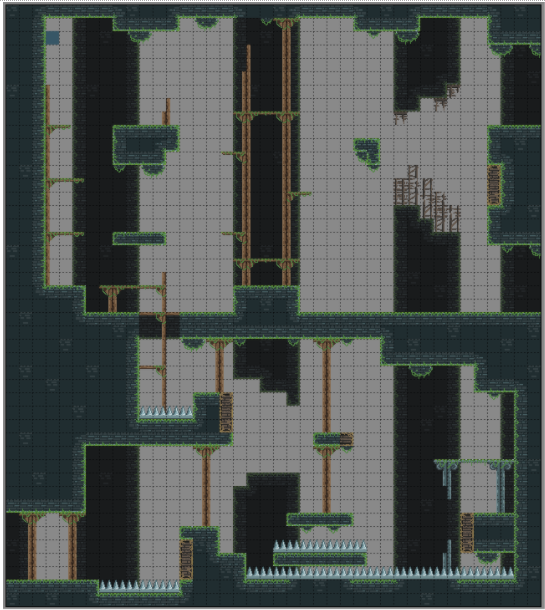
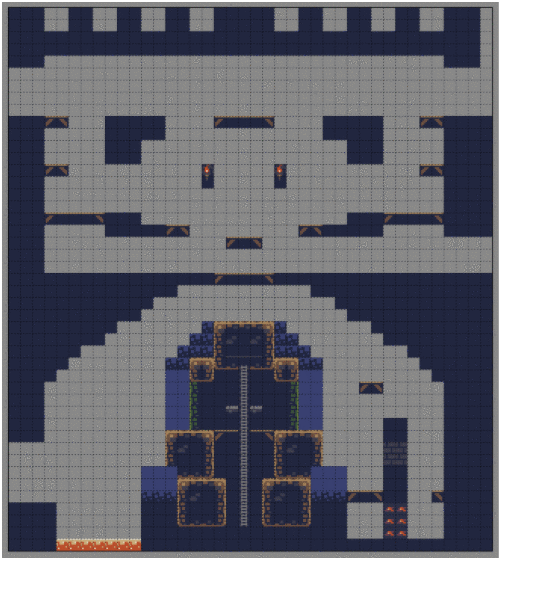
Iteration
Originally, I had the idea for the bottom half of the Moss Tower to be a massive statue platforming challenge, however that didn’t really work with the spear ability, so when it came down to actual development, I quickly altered it into what is in the game now.
Including more wood into the design quickly seemed important to me, as it brought more color into the room & more clearly separated the background and foreground.
The image to the left showcases both the iterative process and the three Moss Tower varieties described above.
Reflection
This room was an interesting challenge, since it is the only room where I had to consider approaching it from three different entrances, with each time a unique path/layout. It definitely cause a headache to keep the versions straight, but in the end it feels the most like a Metroidvania level to me.
Especially the last time you enter this room, playing through the bottom half felt really good. The challenges are self-explanatory, but led to some interesting exploration of the new upgrade. Most levels where the upgrade is relevant weren’t made by me, so this was the one place I got to toy with the mechanic.
All together, perhaps I would have liked to clean it up a bit better and convey the changes from the first to the second version better, but the gameplay itself seems to be at a good level.
Boss Room
Concept
In the early stages of development, this was still meant to be a normal level like the ones prior. It was meant to be a second bridge, divided up into 2 parts. The first part would be a platforming/combat room like all the others, separated by two paths so the player could choose between them. The second room would be boss fight which would end with the floor collapsing and more levels to be revealed to chase the boss.
Those extra levels were scrapped because I had to pick up the Producer role and I did not have the time to develop them, so we moved the Boss Fight forward to make sure we met the deadline.
The original idea was not iterated a lot upon as it became clear these levels were out-of-scope, but I do still have the concepting sketches and an early blockout (right) of what would have been the second bridge and the hazards presented there.
Boss Room Iteration
When we decided to move the boss room forward, there was not a lot of time left so not a lot of iterations took place. I made sure to add platforms for the player to jump over the boss without taking damage. I also added spikes on the sides of the boss room since the player got stuck in the boss’ collision box when they hugged the wall.

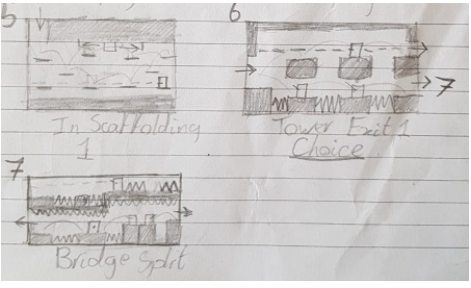
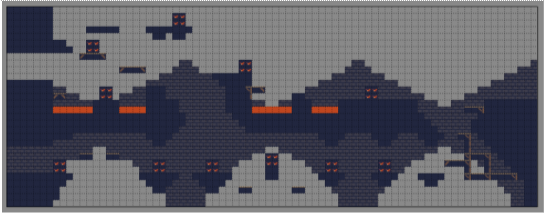
Production
Timeline
In the first of 8 weeks we had to find our game concept and references. We also lost our original producer, which led me to take on the role.
Week 3 and 5 were set as Feature and Content lock, which I used as the building blocks for our timeline.
Hardest Challenges
Prior to this, I had no experience in the Producer role. Together with the Feature Team Leads, we had to overcome multiple hurdles together and keep the team & project together. The largest challenges were:
- No pre-production phase for the project.
- Managing clashing personalities within the team.
- Making the deadlines as the smallest team.
- Working with a custom engine that was still in development.
- Compiling everything to run on the Nintendo Switch.
Learning Achievements
This project taught me a lot of valuable lessons around Game Development and the importance of Production.
- I learned the value and importance of deadlines and milestones, and how setting up smaller goals leading up to the big date can help track how overscoped/delayed features are.
- The value of considering your sprint cards and user stories thoroughly.
- How and when to cut features when pressure gets too high or time runs low, and how to focus on the most important features first.
- Reflections and data insights can greatly improve output and workload estimations.

Production Responsibilities
For this project, I took the following production responsibilities:
- Setting Sprint Goals.
- Scope Management.
- Calculating & Managing Story Points.
- Managing multiple Trello Boards.
- Organize Sprint Reviews & Retrospectives.
- Creating Action Plans with the Feature Team Leads.
- Host Official Presentations.
- Write official DevBlogs on the itch.io page.
Production Document
This document was written during the development of Chaddius Maximus, which highlights each sprint in its Sprint Goals, Burndown Charts, and Action Plans.
Any hyperlinks in the document that would grand access to other people’s data, such as the Trello Boards, have been disabled for the safety of others.

